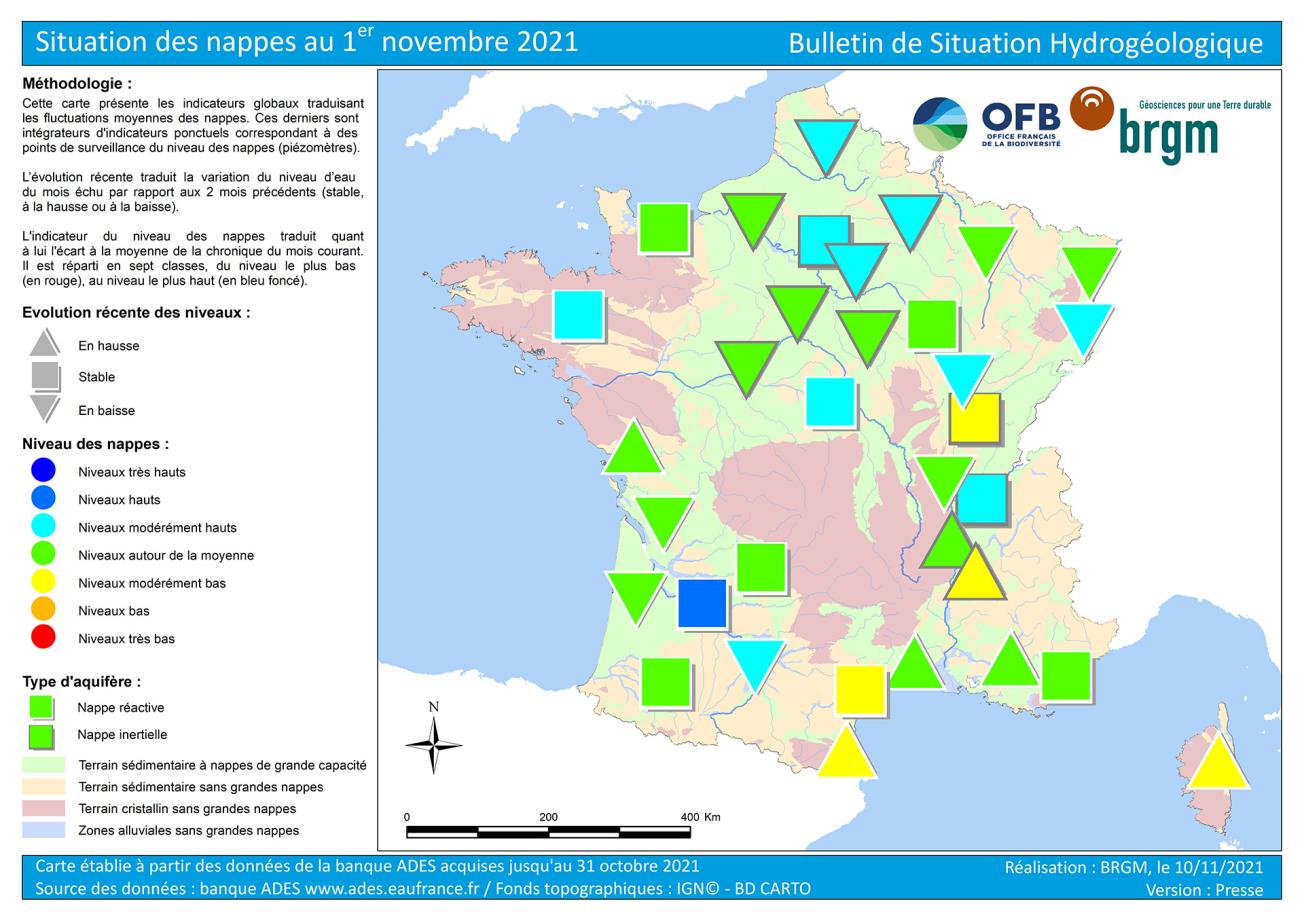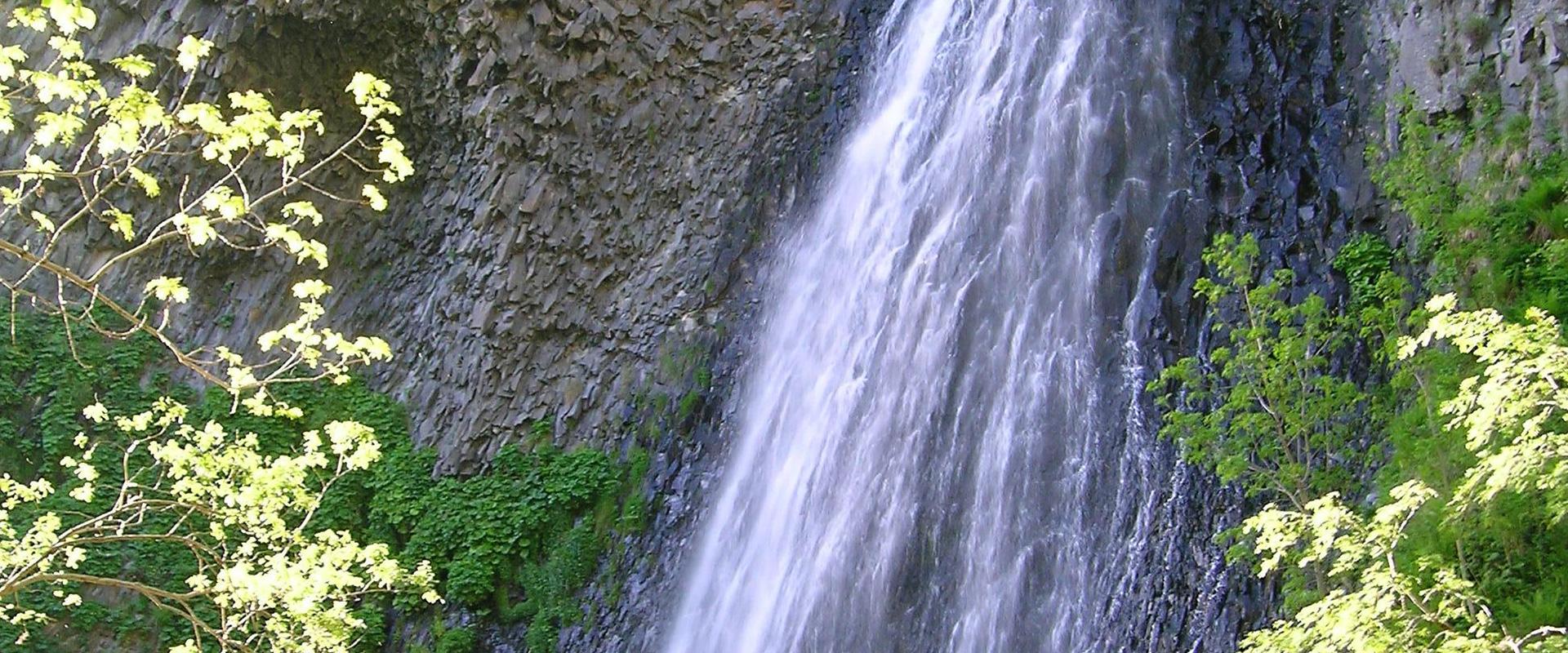
Map of groundwater tables in France on 1 November 2020
© BRGM
Hydrogeological situation on 1 November 2021
In October 2021, the trends were uneven. Over a large southern part of the region, rainfall along with the vegetation entering its dormant period slowed the depletion and initiated recharging of the aquifers. In the aquifers of northern and eastern France, the recharge period has not yet begun and low water levels have not been reached.
The situation in October was satisfactory, with levels close to monthly averages, from moderately low to moderately high. In particular, the situation in the aquifers around the Mediterranean improved during September and October, thanks to the rainfall of those two months.
The trends in November will depend essentially on the rainfall. Recharging should become widespread in the areas receiving rainfall and the situation should then improve. In the event of insufficient rainfall, the aquifers could be depleted again and thus deteriorate.
Trends of groundwater table levels
After a very atypical spring and early summer of 2021, with exceptional recharge episodes, depletion had resumed in August. In September, the trends differed depending on rainfall and the responsiveness of the aquifers.
October 2021 was a transitional period for the aquifers. In the areas with the most rainfall, and with the vegetation entering its dormant period, water was able to infiltrate deeply. This was reflected in a reversal of trends in groundwater levels: in October, 19 of the 34 indicators were up or stable.
The recharge period started in the south-east of France. Thus, the rainfall at the beginning of October led to a recharge episode in the reactive aquifers of Corsica and the Mediterranean coastline, but the trends started to decline again at the end of the month. Levels were stabilising or rising slightly in the inertial Plio-quaternary and Miocene aquifers of the Rhône-Saône corridor. The reactive alluvial aquifers of the Rhône and Saône remained low, due to low rainfall in the upper reaches of their basins (Jura and Alps).
In the west and south-west, the trends were very contrasted and depended on local rainfall: the emptying was slowing down but the recharge period had clearly not yet started. In the aquifers of the Armorican massif basement and Jurassic limestone in the Bessin area, significant rainfall reversed the trends. In Adour-Garonne, levels were gradually stabilising in October in most of the aquifers.
Finally, for the Beauce, Paris Basin, Artois-Picardy and Rhine-Meuse aquifers, the depletion was continuing and levels were still falling overall. These observations can be explained by low rainfall and the significant inertia of certain aquifers in these sectors. However, the fall in levels was easing and the beginning of recharge seemed to be starting in some sectors.
Situation in relation to October averages
In October, the groundwater situation was satisfactory, with moderately low to moderately high levels.
The levels were from around the monthly average to high in the Rhin-Meuse, Artois-Picardy, Seine-Normandy, Loire-Bretagne and Garonne basins. This favourable situation was due in particular to the significant recharge last winter and to the recharge episodes recorded in May-June and then July. The state of the aquifers changed little in October compared to the previous month, even though it deteriorated slightly in the reactive aquifers of the north-east.
In the Rhône basin, the water situation in the reactive alluvial aquifers of the Rhône, the Saône and their tributaries deteriorated slowly but the levels remained satisfactory, from moderately high to comparable to normal. The situation of the inertial aquifers of the Plio-Quaternary and Miocene formations changed little compared to that in September. Aquifer levels were less favourable, from moderately low to moderately high. This situation can be explained by several successive winter recharge deficits that the exceptional inflows of the summer and early autumn did not make up for.
In the south, the situation remained fragile for most of the summer in the reactive aquifers along the Mediterranean coastline and the Corsica, Adour and Gave du Pau aquifers. Rainfall in September and October improved the condition of these aquifers. In October, levels were from comparable to normal to moderately low. However, some sectors remained fragile and still showed critical levels locally, for example in the Montpellier karst aquifers, the Orb alluvial aquifer (Languedoc coastline) and the aquifer of the upper Durance and its tributaries (Provence).
Several aquifers were in very good condition, with high levels in comparison to October levels in previous years:
- The alluvial aquifers of the downstream Garonne and the Dordogne had high levels due to substantial winter recharge and were kept high by the rainfall from May to July;
- The levels of the Picardy and Champagne chalk aquifers were generally moderately high but could be higher locally;
- The Armorican Massif basement aquifers’ levels were moderately high but reached high to very high in the western part.
The situation was not as good for some aquifers, with levels below averages for all Octobers in the chronology:
- Moderately low levels were recorded for the Pliocene pebbles aquifer of Bourgogne-Franche-Comté and the aquifer of the Miocene molasse in the Bas-Dauphiné area. The situation was more strained locally, with low levels in the southern Dijon area and in the Drôme and Isère hills;
- The levels of the alluvial aquifers of the Languedoc coastline and the multi-layer aquifer of Roussillon were moderately low, in a context of low rainfall in October;
- Corsica’s alluvial aquifer levels remained moderately low.
Forecasts
Météo-France’s forecasts for November, December 2021 and January 2022 do not favour any one scenario for temperatures or precipitation for the whole country.
The vegetation went dormant during the month of October. The trends over the next few weeks will depend exclusively on the amount of rainfall, and therefore the rainfall totals, and the inertia of the aquifers.
During September and October, rising or stable water levels were observed in reactive aquifers, for two thirds of southern France. In the event of rainfall, new recharge episodes should be recorded in the reactive aquifers. The situations should then continue to improve. Concerning the inertial aquifers of the Rhône-Saône corridor, the beginning of the recharge should be confirmed and the situation should improve very slowly.
In the north of France, recharge did not start in October. The November rains should reverse the trends and recharge could then become widespread rapidly in the reactive aquifers and more slowly in the inertial aquifers.
If rainfall is insufficient, depletion could resume in the affected aquifers. The situation of the aquifers will deteriorate, particularly in the most reactive aquifers. The state of the aquifers in south-eastern France, weakened by a fairly severe summer low water level, should be carefully monitored.
Hydrological Status Report
The national hydrological status report consists of a set of maps with corresponding comments that show the monthly evolution of water resources. It describes the quantitative situation of aquatic environments (effective rainfall, river discharge, groundwater table levels, reservoir-dam filling status) and provides summary information on Prefectoral Orders issued to limit water use during the low-water period.
Press contact








